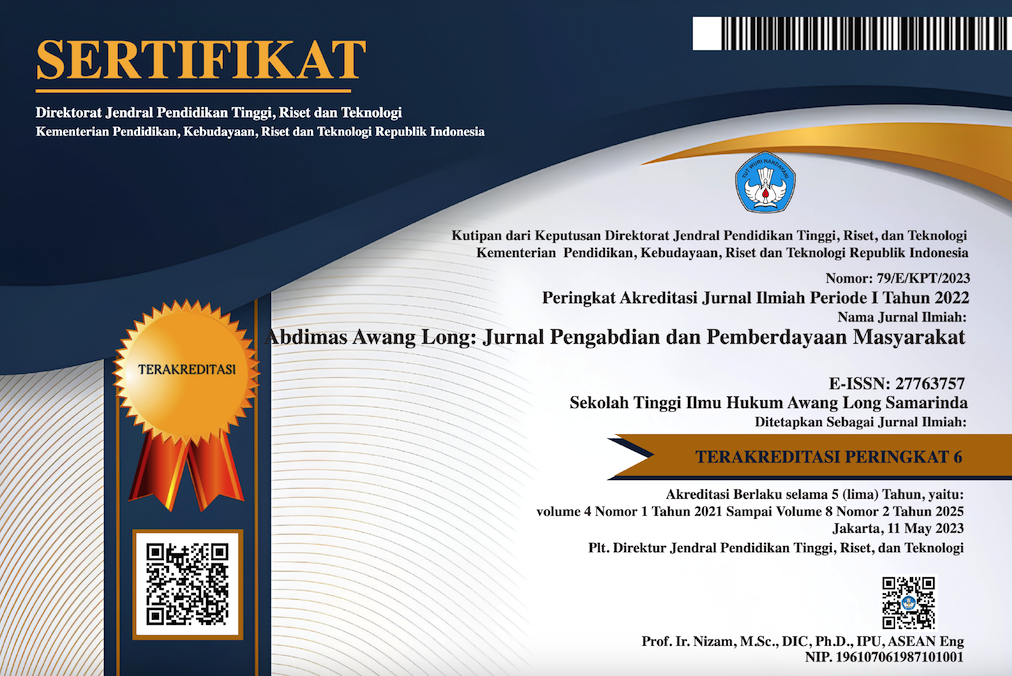CAPACITY BUILDING UNTUK UMKM NAIK KELAS
Abstract
This positive trend needs to continue to maintain its growth so that the MSME sector on a large scale is able to overcome the problem of unemployment in Indonesia. MSMEs are part of the independent Indonesian economy and have great potential to improve people's welfare seen from the three roles of MSMEs in the Indonesian economy, including a means of equalizing the economic level of the small people, a means of alleviating poverty and a means of earning foreign exchange for the country. MSME business with small capital is possible for anyone to do. MSME businesses must develop and be known by the wider community, so that their products can be known and consumed by the wider community. MSME branding aims to involve creating and maintaining a strong and positive brand image in the eyes of consumers. Branding is an effort to build an identity that differentiates a product or service from its competitors. The government is committed to increasing the contribution of micro, small and medium enterprises to the economy. However, the results of various MSME empowerment programs that have been implemented by Ministries and Institutions have not been optimal. Therefore, synchronization and harmonization of MSME empowerment programs is needed to increase the effectiveness of program implementation, so that it can increase the contribution of MSMEs to the economy. Through a community service program called "Capacity Building for MSMEs to Upgrade" the aim is not only to help accelerate national economic growth, but as an effort to empower micro businesses to move up to the scale of small businesses which need to be managed in a more targeted and measurable manner. The program is carried out by providing various materials needed to support the empowerment of MSMEs to advance to class.
Downloads
References
Diarta, I. K. S., Lestari, P. W., Putu, A., & Dewi, C. (2016). Strategi Branding dalam Promosi Penjualan Produk Pertanian Olahan PT . Hatten Bali untuk Pasar Pariwisata Indonesia. 4(2), 170–187.
Fanaqi, C., & Yatnosaputro, R. U. D. S. (2022). Strategi e-marketing umkm produk makanan 3s opieun nheunah di masa pandemi covid-19. 4(1), 1–8.
Irawan, D., & Affan, M. W. (2020). Pendampingan Branding Dan Packaging Umkm Ikatan Pengusaha Aisyiyah Di Kota Malang. 1(1), 32–36. https://doi.org/10.22219/janayu.v1i1.1118 8
Iskandar, J., Prasetya, A., & Fitriyasari, M. (2022). PENGUATAN STRATEGI MARKETING INDUSTRI KREATIF MASYARAKAT (UMKM) MELALUI BRANDING DESIGN. 02(03), 1509–1514.
Kotler, Philip and Gary Amstrong. 2001. PrinsipPrinsip Pemasaran, Jilid 2, Edisi ke-8. Erlangga. Jakarta
Lee, Ming Hsiang, Lee, Chi Ching, dan Wu, Chen Cou. 2011. “Brand Image Strategy Affects Brand Equity after Merger and Acquisitionsâ€. European Jornal of Marketing Vol. 45, No. 7/8. pp. 1091-1111.
Oktaviani, F., Sariwaty, Y., Rahmawati, D., Nf, A. G., & N, D. R. (2018). Penguatan Produk UMKM “ Calief †Melalui Strategi Branding Komunikasi. 1(2), 348–354.
Rowley, Jennifer. (2004). Online branding: the case of McDonald’s. British Food Journal 106 (3): 228-237.
Sugandini, D., Effendi, M. I., Istanto, Y., Arundati, R., & Rahmawat, E. D. (2019). PEMASARAN DIGITAL : ADOPSI MEDIA SOSIAL PADA UKM (Issue November). Zahir Publishing.
Copyright (c) 2024 Badriyah, Herry Syafrial, Setiawan, Susbiyantoro, Edy Sambodja, Febriyanti

This work is licensed under a Creative Commons Attribution-ShareAlike 4.0 International License.







